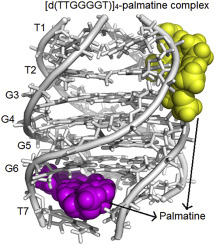Biochimie ( IF 3.3 ) Pub Date : 2018-02-21 , DOI: 10.1016/j.biochi.2018.01.009 Kumar Padmapriya 1 , Ritu Barthwal 1

|
Plant derived small molecules, which interact with and stabilize G-quadruplex DNA, act as inhibitors of telomere elongation and oncogene expression in humans. The inhibition of telomerase enzyme has immense potential since it is over expressed in most cancer cells. Interaction of palmatine, an antitumor alkaloid, to parallel G-quadruplex DNA, [d(TTGGGGT)]4 and [d(TTAGGGT)]4, has been investigated using Nuclear Magnetic Resonance (NMR), fluorescence and Circular Dichroism (CD) spectroscopy. Titrations were monitored by recording 1H and 31P NMR spectra and solution structure of palmatine-[d(TTGGGGT)]4 complex was obtained by restrained Molecular Dynamics (rMD) simulations using distance restraints from 2D NOESY spectra. Thermal stabilization of DNA was determined by CD, 1H NMR and Differential Scanning Calorimetry (DSC). Binding of palmatine induces 98% enhancement of fluorescence accompanied by blue shift ∼8 nm. CD spectral bands of DNA show minor changes. Diffusion NMR studies confirm formation of a stable complex. Proton NMR signals of palmatine shift upfield upon binding and NOE cross peaks of H10, H3, H28, 5OCH3 protons with T2, A3/G3, G6 and T7 residues reveal dual recognition sites in both G-quadruplex DNA sequences, resulting in thermal stabilization of G-quadruplex by ∼13–17 °C. Restrained molecular dynamics simulations using NOE distance restraints for 2:1 palmatine-[d(TTGGGGT)]4 complex reveal end-stacking of palmatine at G6pT7 step and groove binding along T2pG3 step. Binding to [d(TTAGGGT)]4 takes place at T2pA3pG4 and G6pT7 steps. Structural features of molecular recognition of two different G-quadruplex DNA sequences by palmatine have relevance in rational drug development for anti-cancer therapy.
中文翻译:

使用 NMR、荧光和圆二色光谱对原小檗碱生物碱巴马汀与平行 G-四链体 DNA 的双位点结合进行结构和生物物理研究
植物来源的小分子与 G-四链体 DNA 相互作用并稳定其稳定性,可作为人类端粒延长和癌基因表达的抑制剂。端粒酶的抑制具有巨大的潜力,因为它在大多数癌细胞中过度表达。已使用核磁共振 (NMR)、荧光和圆二色性 (CD) 光谱研究了抗肿瘤生物碱巴马汀与平行 G-四链体 DNA [d(TTGGGGT)] 4和 [d(TTAGGGT)] 4的相互作用。通过记录1 H 和31 P NMR 谱来监测滴定,并使用 2D NOESY 谱的距离约束通过约束分子动力学 (rMD) 模拟获得巴马汀-[d(TTGGGGT)] 4复合物的溶液结构。 DNA 的热稳定性通过 CD、 1 H NMR 和差示扫描量热法 (DSC) 测定。巴马汀的结合导致荧光增强 98%,并伴有蓝移~8 nm。 DNA 的 CD 光谱带显示出微小的变化。扩散核磁共振研究证实了稳定复合物的形成。巴马汀的质子 NMR 信号在结合后向上场移动,H10、H3、H28、5OCH 3质子与 T2、A3/G3、G6 和 T7 残基的 NOE 交叉峰揭示了两个 G-四链体 DNA 序列中的双重识别位点,从而实现热稳定G-四链体的温度升高~13–17°C。使用 NOE 距离限制对 2:1 巴马汀-[d(TTGGGGT)] 4复合物进行受限分子动力学模拟,揭示了巴马汀在 G6pT7 步骤的末端堆积以及沿 T2pG3 步骤的凹槽结合。与 [d(TTAGGGT)] 4的结合发生在 T2pA3pG4 和 G6pT7 步骤。 巴马汀对两种不同 G-四链体 DNA 序列的分子识别结构特征与抗癌治疗的合理药物开发相关。











































 京公网安备 11010802027423号
京公网安备 11010802027423号